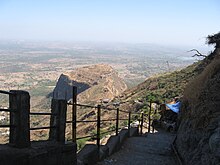Pavagadh
Pavagadh | |
|---|---|
| Pawagadh | |
Panchmahal | |
| Elevation | 762 m (2,500 ft) |

Pavagadh is a municipal operated region in Panchmahal district about 46 kilometres (29 mi) away from Vadodara in Gujarat state in western India. It is known for a famous Mahakali temple which is one of the 51 Shaktipeeths and draws thousands of pilgrims every day. The area of this locality Champaner-Pavagadh Archaeological Park was inscribed by UNESCO as a World Heritage Site in 2004.[1]
History
It is said that king
Patai was defeated and killed. Mahmud Begada shifted his capital from Ahmedabad to Champaner for some time for reasons of diplomacy. He developed the town by constructing buildings such as the fort of Champaner, Uohra mosque, Mandavi, Kirtistambh, the temple of Shalkh, Jama Masjid, Nagina Mosque, and Kevda Mosque. The remains of the Palace of Begada are still found near Vad Talav (Banyan Pond) two kilometers (1.25 miles) away from Champaner by road.
The government has granted many concessions and offered subsidies to the new industries coming up in this area. As a result of it,
Geography

Pavagadh is the gateway to
Notable people
The great music maestro of 16th century, and Tansen's contemporary rival, Baiju Bawra belonged to Champaner.
Reconstruction of the Temple
Pavagadh temple has a controversial history as 15th century king Sultan Mahmud Begda, who ruled Champaner, where the temple is located, is said to have destroyed the "shikhar" or spire of the temple. During that time a shrine "Sadanshah Pir Dargah" was said to have been built in the 11th century temple complex. During the renovation, the dargah was shifted amicably next to the temple and the "shikhar" was constructed. [2]
Places of interest

- pantheon are seen on the outer walls of the temples.[3]
- Kalikamata Temple, a famous Hindu pilgrim centre, is located at Pavagadh. Situated amid dense forest cover on a cliff, the temple is believed to be one of the 51 Shakti Peeths. Maa Mahakalika Udan Khotala (A Passenger Ropeway) is operating since 1986 and takes you quickly and comfortably from Manchi to the hilltop near the Maha Kalika Temple in about 6 minutes, whereas, the steep climb on foot takes over one hour. The temple of Kali is at the height of 550 metres (1,523 feet). A rope-way facility has been made available (commissioned in 1986[4]) to the tourists to reach the temple. About 250 steps have to be climbed from there.
- The remains of the Raval Palace still exist at Machi.
- Then comes Teliya Talav and Dudhia Talav.
- There are numerous tales, songs and dramas knitting the story of Patai Raval.

- Dhaba Dungri is also a famous Shiva Temple located on the way from Halol to Pavagadh. It is also known as "Tapobhumi" of Maharshi Vishwamitra.
- "Virasat Van" is also a beautiful garden located at footstep of Pavagadh.
- Must Visit places also includes "Vada Talav" & "Kabooter Khana" located at footstep of Pavagadh.
References
- ^ Champaner-Pavagadh Archaeological Park
- ^ https://www.deccanherald.com/india/redeveloped-pavagadh-temple-in-line-with-cultural-independence-shows-eternal-faith-says-pm-modi-1119194.html
- ^ B. Busa Goud. "Scientific Conservation of World Heritage Monuments of Champaner-Pavgadh" (pdf). UNESCO. Org. Retrieved 29 September 2012.[permanent dead link]
- ^ "Usha Breco Limited | Maa Kalidevi". Archived from the original on 19 December 2011.
